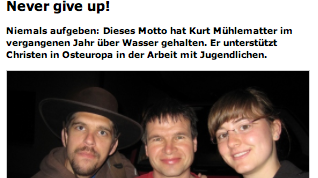In this ideas section we would like to give you some ideas and motivate you to develop your own creative ideas. For the planning and implementation of such projects, read the documents on project management and missionary local work
Painting things and walls
Boring walls, fences, walls, windows, etc. become more fun through children's pictures. Possibly design according to a certain theme or just leave it blank. Old furniture and cars, containers and tires can be painted. To do this, it is best to use emulsion paint, which are durable and waterproof (be careful with the clothes, dried paint is no longer löslich), or spray cans.
Also möpossible on a very large paper. Each boy dips his bare feet in paint and marches criss-cross over the paper. The same can be done with the hands, or one is inspired by new ideas during this activity. For this purpose, however, use water-based paints!
Waste plastic
The material will be collected waste from the village: waste products, household and industrial waste, disposable items, old stuff: old stovepipes, old wind instruments, birdcages, alarm clocks and wall clocks, Büchsen, machine parts, dolls.... The old stuff can be collected in the camp village from the inhabitants (contact with the population) or can be collected at home beforehand, possibly during a debris removal
The plastic is assembled with the help of various objects, and can also be painted. Here the imagination knows no bounds.
Atelier operation
Organization
- The studio operation must be planned and organized well in advance: Finding leaders, organizing Räume, information and scheduling of participants, etc.
- Each studio leader must submit an accurate budget, because craft materials are very expensive! If the participants have to pay something, you should make do with these amounts. Balancing expensive and cheap studios is not fair. Perhaps another fund can make a contribution.
- The larger the number of participants, the more diverse ateliers can be offered. If possible, all participants should find something that suits them. It should be borne in mind that not all techniques are equally suitable for every age group
- The studio operation can last from half a day to several days, depending on the event. But because children and young people have a great need for movement, it is clear that on studio days the opportunity to move and let off steam must be given. If this is not scheduled, the children become restless and stören.
Motivation of the participants
- You print a promotional leaflet or newspaper briefly introducing all the studios
- At the beginning, the ateliers are introduced by the leaders. One can show so also already finished objects.
- It is sometimes difficult to motivate children for a long time. Especially problematic are ateliers in which you can only progress slowly and have to work very precisely. Younger participants usually want to see results quickly. Therefore, it is important to provide a sense of achievement!
Closing Point
A special closing occasion works well as motivation for perseverance
- Exhibition and vernissage for parents
- Parents' evening with presentation (theatre, singing, dancing)
- Newspaper with articles about all the workshops
- Bazaar or stall, etc.
Ideas for studio operations
3.4.1 Workshops
- Record a radio play, reportage, radio programme
- Craft musical instruments
- Puppet show, puppets
- Shadow play, pantomime
- Telling stories
- Playing games in the house
- Volk dance
- Hellroom projector movie
3.4.2 Artist studios
- Collages made from different materials
- Painting stones, possibly including large stones in the riverbed
- Paint community picture
- Paint walls and window panes in the young people's room
- Painting containers
- Mosaic
- Paper batik
- Cord pictures (colored Schüre stick or Nägel in board beat and around it Schnüre stretch)
3.4.3 Natural History
- Sundial
- Cast plaster casts of animal tracks and plants
- Collect and process edible plants
- Coloring with plant dyes
3.4.4 Woodworking
- Root männchen/-figures
- Carve eating utensils (insulate before use!)
- Carve masks or simply paint faces on wood
- Puzzle
- Surrli, Jojo
- Hampelmann
- Train, car, little animal
3.4.5 Textile works
- Weave on cardboard or in branch forks. Weaving in different materials (flowers, blätter ...)
- Knitting, embroidery
- Felting
- Painting with fabric paints
- Wax or cord batik
3.4.6 Printing
- Techniques: string, card, lino, screen printing, woodcut, potato stamps, stencils
- Printing on a T-shirt
3.4.7 Crafts
- Casting pewter (camp badges, medals)
- Baking in homemade oven
- Paint your own körner and bake bread from it
- Bake gingerbread
- Töpfern, possibly find clay yourself
- Leatherwork (jewelry, shoes, purses ...)
- Cook jam
- Soap box für races
3.4.8 Crafting
- Weave a basket out of peddigree cane
- Pour or draw candles
- Kaleidoscope
- Torches, lanterns, lanterns
- Tying knots (hänmat, tie rings, shopping nets)
- Flying objects (hot air balloon, kite, boomerang, parachute, airplane...)
- Water wheel, wind turbine
- Building a city out of cardboard boxes
Pottery
Tools
By far the most important, versatile and subtle tool in sculpting are the hands! If other tools are still necessary, it is not necessarily mandatory to purchase expensive modeling höngs, wire slings, etc. You can make a carved hook or a wire loop for hollowing out objects yourself. A piece of carved wood can serve as a knife
Firing in an open fire
If you don't have a potter with a kiln, you can also fire the potted objects in a normal fire. Small objects made of fireclay are best
The objects must be heated slowly. First, place them near the fire until they are so hot that you can no longer touch them. Now place them with tongs in the middle of the burning logs and gradually put wood on top of the objects. Soon you will see how the things slowly start to glow. Keep firing with lots of thin wood that develops a lot of heat. The brighter the embers get, the hotter the fire.
This experience is worth it, even if individual pieces may shatter in the process.
Decorations
4.3.1 Glazes
Today we can obtain innumerable ready-made art glazes and coat our objects with them. Unfortunately, these ready-made glazes require firing temperatures that are nearly impossible to achieve in a home-built kiln.
4.3.2 Finger Indentations
Try how many patterns you can figure out with fingerprints alone
4.3.3 Corded ware
Insertion of cords into the soft clay results in corded pottery. Firing scorches the cord, which leaves behind a pattern and colors.
4.3.4 Stamps
Seedpods, strongly ground leaves, hulls, sticks, stones and much more can be used as stamps
Carved wooden stamps or even a wooden or clay roller stamp make artistic patterned stamps.
4.3.5 Carving
Using a sharpened hook, you can carve geometric patterns, symbols, pictures, or entire picture stories into the soft clay.
4.3.6 Engobe
Engobe is the name given to fine clay dust that can be mixed with water and used as a coating over the modelled object or to paint an object. A wide range of artificial coloured engobes is available in the shop. However, we can largely stick to nature here as well. For example, if you dissolve dark brown clay in water and paint with the resulting liquid (about as thick as coffee cream) on red-burning clay, the result is a beautiful color combination. Engobe can also be infused with oxides (manganese, iron oxide, copper oxide, etc.)
4.3.7 Sealing
Now how can a pot without glaze be made reasonably tight?
For vessels that have not yet been fired:
- In various cultures it was customary to polish engobed pots quite heavily until the surface became almost glazed.
- Another possibility would be to rub the raw vessel with graphite (crushed pencil lead).
For already fired vessels:
- Fluid beeswax makes a good seal. Afterwards, however, it is recommended not to pour too hot drinks! Instead of wax can also be used liquid resin.
- Rub with hard wax and then polish.
- Hold the jar with tongs üover the flame until it is sooty. Soot seals.
4.3.8 Ideas
4.3.8.1 Thumbshells
This is probably the most primitive way to model a vessel. The lump of clay should be quite moist, otherwise it will crack quickly in the warm hands. It should fit well in the palm of your hand, so it should not be too big. Form a ball and then press a hole in it with your thumb; not too deep, otherwise the bottom will be too thin. Now hold the jar in the hollow of your left hand and use your other hand to widen the hole by pressing with your thumb and index finger simultaneously inside and outside the still thick wall. Turn the jar constantly and work from the bottom to the top. This way the wall will gradually become thinner. This must be done in small steps, the clay must be deformed slowly and should not be torn apart. Take your time!
Feel your jar with your eyes closed, and you feel between your thumb and forefinger where there are still areas that are too thick.
4.3.8.2 Soundstäbe
Make thin clay plates of different sizes (round or square), decorate them and punch out a hole. After firing, tie each slab to a stick or gnarled branch so that they can hang freely and touch as they move.
4.3.8.3 Picture Frame
Prepare an oval, round, or rectangular plate of clay. Cut out a shape that matches the outer shape of the plate. Spread the cut surfaces. Attach the hangers. Decorate the resulting frame by scoring or stamping.
Content may be automatically translated. Help improve the quality of the translation with your editing!


